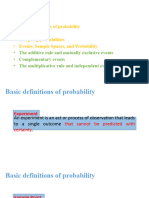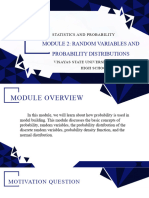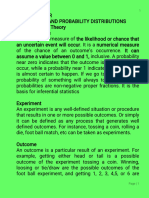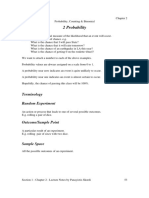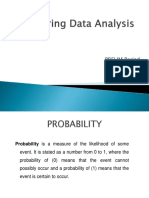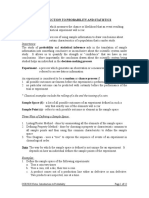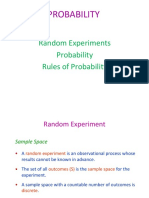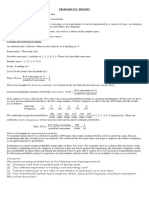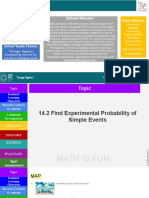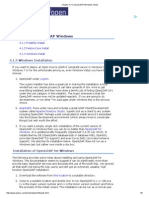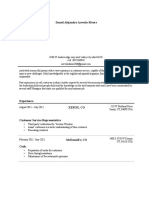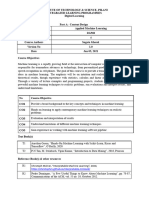Chapter5 Probability
Uploaded by
alkohlanialhasan4848Chapter5 Probability
Uploaded by
alkohlanialhasan4848Name_________________________________________________________ Date __________
Chapter
Maintaining Mathematical Proficiency
5
Write and solve a proportion to answer the question.
1. What percent of 260 is 65?
2. What number is 32% of 75?
3. 15.01 is what percent of 19?
Display the data in a histogram.
4.
Number of Strike-outs
in One Game
Strike-outs 0–3 4–7 8–11
Frequency 34 20 8
5.
Number of Days of
Exercise in One Week
Days of Exercise 0–1 2–3 4–5 6–7
Frequency 4 26 22 6
Copyright © Big Ideas Learning, LLC Integrated Mathematics II 155
All rights reserved. Student Journal
Name _________________________________________________________ Date _________
5.1 Sample Spaces and Probability
For use with Exploration 5.1
Essential Question How can you list the possible outcomes in the
sample space of an experiment?
The sample space of an experiment is the set of all possible outcomes for that experiment.
1 EXPLORATION: Finding the Sample Space of an Experiment
Work with a partner. In an experiment, three coins
are flipped. List the possible outcomes in the sample
space of the experiment.
2 EXPLORATION: Finding the Sample Space of an Experiment
Work with a partner. List the possible outcomes in the sample space of the experiment.
a. One six-sided die is rolled. b. Two six-sided dice are rolled.
3 EXPLORATION: Finding the Sample Space of an Experiment
Work with a partner. In an experiment, a spinner is spun.
1 4
a. How many ways can you spin a 1? 2? 3? 4? 5?
3 2 5
5
5 3
2
5
4 3
156 Integrated Mathematics II Copyright © Big Ideas Learning, LLC
Student Journal All rights reserved.
Name_________________________________________________________ Date __________
5.1 Sample Spaces and Probability (continued)
3 EXPLORATION: Finding the Sample Space of an Experiment (continued)
b. List the sample space.
1 4
3 2 5
5
5 3
c. What is the total number of outcomes? 2
5
4 3
4 EXPLORATION: Finding the Sample Space of an Experiment
Work with a partner. In an experiment, a bag contains 2 blue
marbles and 5 red marbles. Two marbles are drawn from the bag.
a. How many ways can you choose two blue? a red then blue?
a blue then red? two red?
1 2 red
1 3
b. List the sample space. 2
blue 5
4
c. What is the total number of outcomes?
Communicate Your Answer
5. How can you list the possible outcomes in the sample space of an experiment?
6. For Exploration 3, find the ratio of the number of each possible outcome to the
total number of outcomes. Then find the sum of these ratios. Repeat for
Exploration 4. What do you observe?
Copyright © Big Ideas Learning, LLC Integrated Mathematics II 157
All rights reserved. Student Journal
Name _________________________________________________________ Date _________
Notetaking with Vocabulary
5.1 For use after Lesson 5.1
In your own words, write the meaning of each vocabulary term.
probability experiment
outcome
event
sample space
probability of an event
theoretical probability
experimental probability
odds
Core Concepts
Probability of the Complement of an Event
The probability of the complement of event A is
( )
P A = 1 − P ( A).
Notes:
158 Integrated Mathematics II Copyright © Big Ideas Learning, LLC
Student Journal All rights reserved.
Name_________________________________________________________ Date __________
5.1 Notetaking with Vocabulary (continued)
Extra Practice
In Exercises 1 and 2, find the number of possible outcomes in the sample space.
Then list the possible outcomes.
1. A stack of cards contains the thirteen clubs from a standard deck of cards. You pick a card
from the stack and flip two coins.
2. You spin a spinner with the numbers 1–5 on it and roll a die.
3. When two tiles with numbers between 1 and 10 are chosen from two different bags,
there are 100 possible outcomes. Find the probability that (a) the sum of the two
numbers is not 10 and (b) the product of the numbers is greater than 10.
4. At a school dance, the parents sell pizza slices. The table shows the number of pizza
slices that are available. A student chooses a slice at random. What is the probability
that the student chooses a thin crust slice with pepperoni?
Pepperoni Plain Cheese
Thin Crust 34 36
Thick Crust 8 12
Copyright © Big Ideas Learning, LLC Integrated Mathematics II 159
All rights reserved. Student Journal
Name _________________________________________________________ Date _________
5.1 Notetaking with Vocabulary (continued)
5. Find the probability that the polynomial x 2 − x − c can be factored if c is a randomly
chosen integer from 1 to 12.
6. The sections of a spinner are numbered 1 through 12. Each section of the spinner has
the same area. You spin the spinner 180 times. The table shows the results. For which
number is the experimental probability of stopping on the number the same as the
theoretical probability?
Spinner Results
1 2 3 4 5 6 7 8 9 10 11 12
13 21 22 20 11 8 14 9 15 12 18 17
7. Use the spinner in Exercise 6 to find the given odds.
a. in favor of stopping on a number greater than 8
b. against stopping on a number that is a multiple of 3
160 Integrated Mathematics II Copyright © Big Ideas Learning, LLC
Student Journal All rights reserved.
Name_________________________________________________________ Date __________
5.2 Independent and Dependent Events
For use with Exploration 5.2
Essential Question How can you determine whether two events are
independent or dependent?
Two events are independent events when the occurrence of one event does not affect the occurrence of the
other event. Two events are dependent events when the occurrence of one event does affect the occurrence
of the other event.
1 EXPLORATION: Identifying Independent and Dependent Events
Work with a partner. Determine whether the events are independent or dependent.
Explain your reasoning.
a. Two six-sided dice are rolled.
b. Six pieces of paper, numbered 1 through 6, are in a bag. Two pieces of paper
are selected one at a time without replacement.
2 EXPLORATION: Finding Experimental Probabilities
Go to BigIdeasMath.com for an interactive tool to investigate this exploration.
Work with a partner.
a. In Exploration 1(a), experimentally estimate the probability that the sum of the
two numbers rolled is 7. Describe your experiment.
b. In Exploration 1(b), experimentally estimate the probability that the sum of the
two numbers selected is 7. Describe your experiment.
Copyright © Big Ideas Learning, LLC Integrated Mathematics II 161
All rights reserved. Student Journal
Name _________________________________________________________ Date _________
5.2 Independent and Dependent Events (continued)
3 EXPLORATION: Finding Theoretical Probabilities
Work with a partner.
a. In Exploration 1(a), find the theoretical probability that the sum of the two
numbers rolled is 7. Then compare your answer with the experimental
probability you found in Exploration 2(a).
b. In Exploration 1(b), find the theoretical probability that the sum of the two
numbers selected is 7. Then compare your answer with the experimental
probability you found in Exploration 2(b).
c. Compare the probabilities you obtained in parts (a) and (b).
Communicate Your Answer
4. How can you determine whether two events are independent or dependent?
5. Determine whether the events are independent or dependent. Explain your
reasoning.
a. You roll a 4 on a six-sided die and spin red on a spinner.
b. Your teacher chooses a student to lead a group, chooses another student to lead
a second group, and chooses a third student to lead a third group.
162 Integrated Mathematics II Copyright © Big Ideas Learning, LLC
Student Journal All rights reserved.
Name_________________________________________________________ Date __________
Notetaking with Vocabulary
5.2 For use after Lesson 5.2
In your own words, write the meaning of each vocabulary term.
independent events
dependent events
conditional probability
Core Concepts
Probability of Independent Events
Words Two events A and B are independent events if and only if the probability that
both events occur is the product of the probabilities of the events.
Symbols P ( A and B ) = P ( A) • P ( B)
Notes:
Copyright © Big Ideas Learning, LLC Integrated Mathematics II 163
All rights reserved. Student Journal
Name _________________________________________________________ Date _________
5.2 Notetaking with Vocabulary (continued)
Probability of Dependent Events
Words If two events A and B are dependent events, then the probability that both events
occur is the product of the probability of the first event and the conditional
probability of the second event given the first event.
Symbols P ( A and B ) = P ( A) • P ( B A)
Example Using the information in Example 2:
P (girl first and girl second ) = P (girl first ) • P (girl second girl first )
9 6 1
= • =
12 9 2
Notes:
Extra Practice
In Exercises 1 and 2, determine whether the events are independent. Explain your
reasoning.
1. You have three white golf balls and two yellow golf balls in a bag. You randomly select
one golf ball to hit now and another golf ball to place in your pocket. Use a sample space
to determine whether randomly selecting a white golf ball first and then a white golf ball
second are independent events.
2. Your friend writes a phone number down on a piece of paper but the last three numbers
get smudged after being in your pocket all day long. You decide to randomly choose
numbers for each of the three digits. Use a sample space to determine whether guessing
the first digit correctly and the second digit correctly are independent events.
164 Integrated Mathematics II Copyright © Big Ideas Learning, LLC
Student Journal All rights reserved.
Name_________________________________________________________ Date __________
5.2 Notetaking with Vocabulary (continued)
3. You are trying to guess a three-letter password that uses only the letters A, E, I, O, U,
and Y. Letters can be used more than once. Find the probability that you pick the
correct password “YOU.”
4. You are trying to guess a three-letter password that uses only the letters A, E, I, O, U,
and Y. Letters cannot be used more than once. Find the probability that you pick the
correct password “AIE.”
5. The table shows the number of male and female college students who played collegiate basketball
and collegiate soccer in the United States in a recent year.
Collegiate Soccer Collegiate Basketball
Male 37,240 31,863
Female 36,523 28,002
a. Find the probability that a randomly selected collegiate soccer player is female.
b. Find the probability that a randomly selected male student is a collegiate basketball player.
Copyright © Big Ideas Learning, LLC Integrated Mathematics II 165
All rights reserved. Student Journal
Name _________________________________________________________ Date _________
5.3 Two-Way Tables and Probability
For use with Exploration 5.3
Essential Question How can you construct and interpret a two-way
table?
1 EXPLORATION: Completing and Using a Two-Way Table
Work with a partner. A two-way table displays the same information as a Venn diagram. In
a two-way table, one category is represented by the rows and the other category is
represented by the columns.
The Venn diagram shows the results of a survey in which 80 students were asked whether
they play a musical instrument and whether they speak a foreign language. Use the Venn
diagram to complete the two-way table. Then use the two-way table to answer each question.
Survey of 80 Students Play an Do Not Play
Instrument an Instrument Total
Speak a Speak a Foreign
Play an
foreign
instrument Language
16 language
25 30 Do Not Speak a
Foreign Language
9
Total
a. How many students play an instrument?
b. How many students speak a foreign language?
c. How many students play an instrument and speak a foreign language?
d. How many students do not play an instrument and do not speak a foreign
language?
e. How many students play an instrument and do not speak a foreign language?
2 EXPLORATION: Two-Way Tables and Probability
Work with a partner. In Exploration 1, one student is selected at random from the 80
students who took the survey. Find the probability that the student
a. plays an instrument.
166 Integrated Mathematics II Copyright © Big Ideas Learning, LLC
Student Journal All rights reserved.
Name_________________________________________________________ Date __________
5.3 Two-Way Tables and Probability (continued)
2 EXPLORATION: Two-Way Tables and Probability (continued)
b. speaks a foreign language.
c. plays an instrument and speaks a foreign language.
d. does not play an instrument and does not speak a foreign language.
e. plays an instrument and does not speak a foreign language.
3 EXPLORATION: Conducting a Survey
Go to BigIdeasMath.com for an interactive tool to investigate this exploration.
Work with your class. Conduct a survey of students in your class. Choose two
categories that are different from those given in Explorations 1 and 2. Then summarize
the results in both a Venn diagram and a two-way table. Discuss the results.
Communicate Your Answer
4. How can you construct and interpret a two-way table?
5. How can you use a two-way table to determine probabilities?
Copyright © Big Ideas Learning, LLC Integrated Mathematics II 167
All rights reserved. Student Journal
Name _________________________________________________________ Date _________
Notetaking with Vocabulary
5.3 For use after Lesson 5.3
In your own words, write the meaning of each vocabulary term.
two-way table
joint frequency
marginal frequency
joint relative frequency
marginal relative frequency
conditional relative frequency
Core Concepts
Relative and Conditional Relative Frequencies
A joint relative frequency is the ratio of a frequency that is not in the total row or the total
column to the total number of values or observations.
A marginal relative frequency is the sum of the joint relative frequencies in a row or a column.
A conditional relative frequency is the ratio of a joint relative frequency to the marginal
relative frequency. You can find a conditional relative frequency using a row total or a column
total of a two-way table.
Notes:
168 Integrated Mathematics II Copyright © Big Ideas Learning, LLC
Student Journal All rights reserved.
Name_________________________________________________________ Date __________
5.3 Notetaking with Vocabulary (continued)
Extra Practice
In Exercises 1 and 2, complete the two-way table.
1.
Arrival
Tardy On Time Total
Walk 22
Method
City Bus 60
Total 58 130
2.
Response
Yes No Total
Under 21 24 25
Age
Over 21 29
Total 30 75
3. A survey was taken of 100 families with one child and 86 families with two or more
children to determine whether they were saving for college. Of those, 94 of the families
with one child and 60 of the families with two or more children were saving for college.
Organize these results in a two-way table. Then find and interpret the marginal frequencies.
Copyright © Big Ideas Learning, LLC Integrated Mathematics II 169
All rights reserved. Student Journal
Name _________________________________________________________ Date _________
5.3 Notetaking with Vocabulary (continued)
4. In a survey, 214 ninth graders played video games every day of the week and 22 ninth graders
did not play video games every day of the week. Of those that played every day of the week,
36 had trouble sleeping at night. Of those that did not play every day of the week, 7 had trouble
sleeping at night. Make a two-way table that shows the joint and marginal relative frequencies.
5. For financial reasons, a school district is debating about eliminating a Computer Programming
class at the high school. The district surveyed parents, students, and teachers. The results, given
as joint relative frequencies, are shown in the two-way table.
Population
Parents Students Teachers
Response
Yes 0.58 0.08 0.10
No 0.06 0.15 0.03
a. What is the probability that a randomly selected parent voted to eliminate the class?
b. What is the probability that a randomly selected student did not want to eliminate the class?
c. Determine whether voting to eliminate the class and being a teacher are independent events.
170 Integrated Mathematics II Copyright © Big Ideas Learning, LLC
Student Journal All rights reserved.
Name_________________________________________________________ Date __________
5.4 Probability of Disjoint and Overlapping Events
For use with Exploration 5.4
Essential Question How can you find probabilities of disjoint and
overlapping events?
Two events are disjoint, or mutually exclusive, when they have no outcomes in common. Two events are
overlapping when they have one or more outcomes in common.
1 EXPLORATION: Disjoint Events and Overlapping Events
Go to BigIdeasMath.com for an interactive tool to investigate this exploration.
Work with a partner. A six-sided die is rolled. Draw a Venn diagram that relates the
two events. Then decide whether the events are disjoint or overlapping.
a. Event A: The result is an even number. b. Event A: The result is 2 or 4.
Event B: The result is a prime number. Event B: The result is an odd number.
2 EXPLORATION: Finding the Probability that Two Events Occur
Work with a partner. A six-sided die is rolled. For each pair of events, find
(a) P ( A), (b) P ( B ), (c) P ( A and B ), and (d) P ( A or B ).
a. Event A: The result is an even number.
Event B: The result is a prime number.
b. Event A: The result is a 2 or 4.
Event B: The result is an odd number.
Copyright © Big Ideas Learning, LLC Integrated Mathematics II 171
All rights reserved. Student Journal
Name _________________________________________________________ Date _________
5.4 Probability of Disjoint and Overlapping Events (continued)
3 EXPLORATION: Discovering Probability Formulas
Go to BigIdeasMath.com for an interactive tool to investigate this exploration.
Work with a partner.
a. In general, if event A and event B are disjoint, then what is the probability that
event A or event B will occur? Use a Venn diagram to justify your conclusion.
b. In general, if event A and event B are overlapping, then what is the probability
that event A or event B will occur? Use a Venn diagram to justify your
conclusion.
c. Conduct an experiment using a six-sided die. Roll the die 50 times and record
the results. Then use the results to find the probabilities described in
Exploration 2. How closely do your experimental probabilities compare to the
theoretical probabilities you found in Exploration 2?
Communicate Your Answer
4. How can you find probabilities of disjoint and overlapping events?
5. Give examples of disjoint events and overlapping events that do not involve dice.
172 Integrated Mathematics II Copyright © Big Ideas Learning, LLC
Student Journal All rights reserved.
Name_________________________________________________________ Date __________
Notetaking with Vocabulary
5.4 For use after Lesson 5.4
In your own words, write the meaning of each vocabulary term.
compound event
overlapping events
disjoint or mutually exclusive events
Core Concepts
Probability of Compound Events
If A and B are any two events, then the probability of A or B is
P( A or B) = P( A) + P( B) − P( A and B).
If A and B are disjoint events, then the probability of A or B is
P( A or B) = P( A) + P( B).
Notes:
Copyright © Big Ideas Learning, LLC Integrated Mathematics II 173
All rights reserved. Student Journal
Name _________________________________________________________ Date _________
5.4 Notetaking with Vocabulary (continued)
Extra Practice
1. Events A and B are disjoint. P ( A) = 2 and P ( B ) = 1 . Find P( A or B).
3 6
2. P( A) = 0.8, P( B) = 0.05, and P( A or B) = 0.6. Find P( A and B).
In Exercises 3–6, a vehicle is randomly chosen from a parking lot. The parking lot
contains three red minivans, two blue minivans, three blue convertibles, one black
pickup truck, three black motorcycles, one red motorcycle and two blue scooters.
Find the probability of selecting the type of vehicle.
3. A red vehicle or a minivan
4. A scooter or a black vehicle
5. A black vehicle or a motorcycle
6. A four-wheeled vehicle or a blue vehicle
174 Integrated Mathematics II Copyright © Big Ideas Learning, LLC
Student Journal All rights reserved.
Name_________________________________________________________ Date __________
5.4 Notetaking with Vocabulary (continued)
7. During a basketball game, the coach needs to select a player to make the free throw after a technical
foul on the other team. There is a 68% chance that the coach will select you and a 26% chance that
the coach will select your friend. What is the probability that you or your friend is selected to make
the free throw?
8. Two six-sided dice are rolled. Find the probability of rolling the same number twice.
9. Out of 120 student parents, 90 of them can chaperone the Homecoming dance or the Prom. There are
40 parents who can chaperone the Homecoming dance and 65 parents who can chaperone the Prom.
What is the probability that a randomly selected parent can chaperone both the Homecoming dance
and the Prom?
10. A football team scores a touchdown first 75% of the time when they start with the ball. The team
does not score first 51% of the time when their opponent starts with the ball. The team who gets the
ball first is determined by a coin toss. What is the probability that the team scores a touchdown first?
Copyright © Big Ideas Learning, LLC Integrated Mathematics II 175
All rights reserved. Student Journal
Name _________________________________________________________ Date _________
5.5 Permutations and Combinations
For use with Exploration 5.5
Essential Question How can a tree diagram help you visualize the
number of ways in which two or more events can occur?
1 EXPLORATION: Reading a Tree Diagram
Work with a partner. Two coins are flipped and the spinner is spun.
The tree diagram shows the possible outcomes. 1 2
3
H T Coin is flipped.
H T H T Coin is flipped.
1 2 3 1 2 3 1 2 3 1 2 3 Spinner is spun.
a. How many outcomes are possible?
b. List the possible outcomes.
2 EXPLORATION: Reading a Tree Diagram
Work with a partner. Consider the tree diagram below.
A B
1 2 3 1 2 3
X Y X Y X Y X Y X Y X Y
A B A B A B A B A B A B A B A B A B A B A B A B
a. How many events are shown? b. What outcomes are possible for each event?
c. How many outcomes are possible? d. List the possible outcomes.
176 Integrated Mathematics II Copyright © Big Ideas Learning, LLC
Student Journal All rights reserved.
Name_________________________________________________________ Date __________
5.5 Permutations and Combinations (continued)
3 EXPLORATION: Writing a Conjecture
Work with a partner.
a. Consider the following general problem: Event 1 can occur in m ways and
event 2 can occur in n ways. Write a conjecture about the number of ways the
two events can occur. Explain your reasoning.
b. Use the conjecture you wrote in part (a) to write a conjecture about the number
of ways more than two events can occur. Explain your reasoning.
c. Use the results of Explorations 1(a) and 2(c) to verify your conjectures.
Communicate Your Answer
4. How can a tree diagram help you visualize the number of ways in which two or
more events can occur?
5. In Exploration 1, the spinner is spun a second time. How many outcomes are
possible?
Copyright © Big Ideas Learning, LLC Integrated Mathematics II 177
All rights reserved. Student Journal
Name _________________________________________________________ Date _________
Notetaking with Vocabulary
5.5 For use after Lesson 5.5
In your own words, write the meaning of each vocabulary term.
permutation
n factorial
combination
Core Concepts
Permutations
Formulas Examples
The number of permutations The number of permutations of 4
of n objects is given by objects is
n Pn = n!. 4 P4 = 4! = 4 • 3 • 2 • 1 = 24.
The number of permutations The number of permutations of 4
of n objects taken r at a time, objects taken 2 at a time is
where r ≤ n, is given by
4! 4 • 3 • 2!
n! 4 P2 = = = 12.
n Pr = . (4 − 2)! 2!
(n − r )!
Notes:
178 Integrated Mathematics II Copyright © Big Ideas Learning, LLC
Student Journal All rights reserved.
Name_________________________________________________________ Date __________
5.5 Notetaking with Vocabulary (continued)
Combinations
Formula The number of combinations of n objects taken r at a time, where
r ≤ n, is given by
n!
n Cr = .
(n − r )! • r !
Example The number of combinations of 4 objects taken 2 at a time is
4! 4 • 3 • 2!
4 C2 = = = 6.
(4 − 2)! • 2! 2! • (2 • 1)
Notes:
Copyright © Big Ideas Learning, LLC Integrated Mathematics II 179
All rights reserved. Student Journal
Name _________________________________________________________ Date _________
5.5 Notetaking with Vocabulary (continued)
Extra Practice
In Exercises 1 and 2, find the number of ways you can arrange (a) all of the
numbers and (b) 3 of the numbers in the given amount.
1. $2,564,783 2. $4,128,675,309
3. Your rock band has nine songs recorded but you only want to put five of them on your
demo CD to hand out to local radio stations. How many possible ways could the five
songs be ordered on your demo CD?
4. A witness at the scene of a hit-and-run accident saw that the car that caused the accident
had a license plate with only the letters I, R, L, T, O, and A. Find the probability that the
license plate starts with a T and ends with an R.
5. How many possible combinations of three colors can be chosen from the seven colors of
the rainbow?
180 Integrated Mathematics II Copyright © Big Ideas Learning, LLC
Student Journal All rights reserved.
Name_________________________________________________________ Date __________
5.6 Binomial Distributions
For use with Exploration 5.6
Essential Question How can you determine the frequency of each
outcome of an event?
1 EXPLORATION: Analyzing Histograms
Go to BigIdeasMath.com for an interactive tool to investigate this exploration.
Work with a partner. The histograms show the results when n coins are flipped.
1 1 2 3 3
n=1 1 1
0 1 n=2 1 1
Number of Heads 0 1 2 n=3
Number of Heads 0 1 2 3
Number of Heads
6 10 10
4 4
1 1 5 5
n=4
0 1 2 3 4
Number of Heads
1 1
n=5
0 1 2 3 4 5
Number of Heads
a. In how many ways can 3 heads occur when 5 coins are flipped?
b. Draw a histogram that shows the numbers of
heads that can occur when 6 coins are flipped.
c. In how many ways can 3 heads occur when
6 coins are flipped?
Copyright © Big Ideas Learning, LLC Integrated Mathematics II 181
All rights reserved. Student Journal
Name _________________________________________________________ Date _________
5.6 Binomial Distributions (continued)
2 EXPLORATION: Determining the Number of Occurrences
Work with a partner.
a. Complete the table showing the numbers of ways in which 2 heads can occur
when n coins are flipped.
n 3 4 5 6 7
Occurrences of 2 heads
b. Determine the pattern shown in the table. Use your result to find the number
of ways in which 2 heads can occur when 8 coins are flipped.
Communicate Your Answer
3. How can you determine the frequency of each outcome of an event?
4. How can you use a histogram to find the probability of an event?
182 Integrated Mathematics II Copyright © Big Ideas Learning, LLC
Student Journal All rights reserved.
Name_________________________________________________________ Date __________
Notetaking with Vocabulary
5.6 For use after Lesson 5.6
In your own words, write the meaning of each vocabulary term.
random variable
probability distribution
binomial distribution
binomial experiment
Core Concepts
Probability Distributions
A probability distribution is a function that gives the probability of each possible value of a random
variable. The sum of all the probabilities in a probability distribution must equal 1.
Probability Distribution for Rolling a Six-Sided Die
x 1 2 3 4 5 6
1 1 1 1 1 1
P (x)
6 6 6 6 6 6
Notes:
Copyright © Big Ideas Learning, LLC Integrated Mathematics II 183
All rights reserved. Student Journal
Name _________________________________________________________ Date _________
5.6 Notetaking with Vocabulary (continued)
Binomial Experiments
A binomial experiment meets the following conditions.
• There are n independent trials.
• Each trial has only two possible outcomes: success and failure.
• The probability of success is the same for each trial. This probability is denoted by p. The
probability of failure is 1 − p.
For a binomial experiment, the probability of exactly k successes in n trials is
n−k
P ( k successes) = n Ck p k (1 − p ) .
Notes:
Extra Practice
1. Make a table and draw a histogram showing the probability distribution for the random
variable P if P = the product when two six-sided dice are rolled.
184 Integrated Mathematics II Copyright © Big Ideas Learning, LLC
Student Journal All rights reserved.
Name_________________________________________________________ Date __________
5.6 Notetaking with Vocabulary (continued)
2. Use the probability distribution to determine (a) the number that is most likely to be spun on a
spinner, and (b) the probability of spinning a perfect square.
Spinner Results
P(x)
0.8
Probability
0.6
0.4
0.2
0
1 2 3 4 5 x
Number on spinner
3. Calculate the probability of flipping a coin twenty times and getting nineteen heads.
4. According to a survey, 78% of women in a city watch professional football. You ask four randomly
chosen women from the city whether they watch professional football.
a. Draw a histogram of the binomial distribution for your survey.
b. What is the most likely outcome of your survey?
c. What is the probability that at most one woman watches professional football?
Copyright © Big Ideas Learning, LLC Integrated Mathematics II 185
All rights reserved. Student Journal
You might also like
- SLM - Math 8 Q4 WK 5 Module 5 JMarzan FINALNo ratings yetSLM - Math 8 Q4 WK 5 Module 5 JMarzan FINAL19 pages
- Introduction To The Concept of Probability100% (1)Introduction To The Concept of Probability32 pages
- Lesson 2.1 and 2.2 Probability and Random VariablesNo ratings yetLesson 2.1 and 2.2 Probability and Random Variables50 pages
- Probability: Interactive Math Goodies SoftwareNo ratings yetProbability: Interactive Math Goodies Software7 pages
- Math 2 Unit 9 - Probability: Lesson 1: "Sample Spaces, Subsets, and Basic Probability"100% (1)Math 2 Unit 9 - Probability: Lesson 1: "Sample Spaces, Subsets, and Basic Probability"87 pages
- Probability: Random Experiments Probability Rules of ProbabilityNo ratings yetProbability: Random Experiments Probability Rules of Probability62 pages
- P1 Gr7 14.2 Find Experimental Probability of Simple EventsNo ratings yetP1 Gr7 14.2 Find Experimental Probability of Simple Events20 pages
- Professional Practices in Information Technology: Hand BookNo ratings yetProfessional Practices in Information Technology: Hand Book131 pages
- Chapter 4.1 Install openLDAP For Windows PDFNo ratings yetChapter 4.1 Install openLDAP For Windows PDF6 pages
- March 2025 Lept Exam Program (Prof Teachers) Revised March 2025No ratings yetMarch 2025 Lept Exam Program (Prof Teachers) Revised March 20252 pages
- Bilingual Customer Service & Tech Support ResumeNo ratings yetBilingual Customer Service & Tech Support Resume3 pages
- (Ebook PDF) Calculus For AP: A Complete Course PDF Download100% (6)(Ebook PDF) Calculus For AP: A Complete Course PDF Download50 pages
- Panvalet Users Guide: Number: 11.04.01 Effective: 08/01/01No ratings yetPanvalet Users Guide: Number: 11.04.01 Effective: 08/01/0171 pages
- 600 Questões Sobre Inspeção de Soldagem Incluíndo Gabarito e Caderno de DesenhosNo ratings yet600 Questões Sobre Inspeção de Soldagem Incluíndo Gabarito e Caderno de Desenhos9 pages
- Session 8 - LTI Systems (III) - ConvolutionNo ratings yetSession 8 - LTI Systems (III) - Convolution19 pages
- A Note On The "Implicit" Method For Finite-Difference Heat-Transfer CalculationsNo ratings yetA Note On The "Implicit" Method For Finite-Difference Heat-Transfer Calculations2 pages
- ANTLMonitoring - MRBTS-525536 - MED - Bello Sauces - WN19 - FL19 - GF19 - SBTS19B - ENB - 0000 - 001696 - 000000 - 20210211-1157No ratings yetANTLMonitoring - MRBTS-525536 - MED - Bello Sauces - WN19 - FL19 - GF19 - SBTS19B - ENB - 0000 - 001696 - 000000 - 20210211-11576 pages







